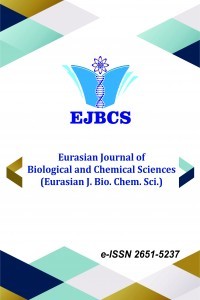Morphological and molecular identification of fungi isolated from various habitat in Kirkuk city – Iraq
Morphological and molecular identification of fungi isolated from various habitat in Kirkuk city – Iraq
Aspergillus flavus, Penicillium citrinum, Kirkuk,
___
- Anderson IC, Parkin PI. 2007. Detection of active soil fungi by RT-PCR amplification of precursor rRNA molecules. Microbiol Methods. 68:248–253.
- Bermingham S, Maltby L, Cooke RC. 1996. Effect of acoal mine effluent on aquatic hyphomycetes. Field Study Appl Ecol. 33: 1311-1321.
- Cappccino JG, Sherman N. 1996. Microbiology. alaboratory manual. 4th edu. Benjamin. Cummings pub.
- Chandrashekar MA, Soumya Pai K, Raju NS. 2014. Fungal Diversity of Rhizosphere Soils in Different Agricultural fields of Nanjangud Taluk of Mysore District. Karnataka. India. Int.J.Curr.Microbiol.App.Sci. 3:559-566.
- Gaddeyya G, Niharika PS, Bharathi P, Kumar PKR. 2012. Isolation and identification of soil mycoflora in different crop fields at Salur Mandal. AdvAppl Sci Res. 3:2020-2026.
- Gravesen S, Frisvad JC, Samson RA. 1994. Microfungi. Munksgaard Publishers. Copenhagen.
- Jasuja ND, Saxena R, Chandra S, Joshi SC. 2013. Isolation and identification of microorganism from polyhouse agriculture soil of Rajasthan. African J Microbiol Res. 7: 4886-4891. Javadi MA, Ghanbary MAT, Tazick Z. 2012. Isolation and molecular identification of soil inhabitant Penicillia. Ann of Biol Res. 3: 5758-5761. Kamel T. 2013. Mesopotamia in Mesopotamia. Iraqi Nation Studies Center. www.mesopotamia4374.com/dose/ Mesopotamia in Mesopotamia. Iraqi Nation Studies Center. Accessed 20 Oct 2013.
- Lutzoni F, Kauff F, Cox CJ, Laughlin D, Celio G. 2004. Assembling the fungal tree of life progress classification and evolution of the subcellular traits. Am J Bot. 91: 1446-1480.
- Nollet LM. 2007. Handbook of water analysis. 2PndP ed. CRC Press. London.
- Pellon A, Sadeghi N, Moyes DL. 2020. New insights in Candida albicans innate immunity at the mucosa toxins epithelium metabolism and beyond. Frontiers in cellular and infection microbiology.10-81.
- Reddy PL, Babu BS, Radhaiah A, Sreeramulu A. 2014. Screening, identification and isolation of cellulolytic fungi from soils of Chittoor District. India. Int J Curr Microbiol Appl Sci. 3: 761-771. Sharma MS, Raju NS. 2013. Frequency and percentage occurrence of soil mycoflora in different crop fields at H D Kote of Mysore district. Inter J Environ Sci. 3: 1569-1576.
- Wang JH, Zhang HP, gong S, Xue RS, Agboola Y, Liao C. 2014. Molecular identification mycotoxin production and comparative pathogenicity of Fusariumtemperatum isolated from maize in China. J. Phytopathol. 162:147-157.
- Wang Z, Nilsson RH, James TY, Dai Y, Townsend JP. 2016. Biology of Microfungi. pp 25−46.
- Webster J, Weber RA. 2007. Introduction to fungi. In: Jack S. Fungi, 3rd edn. New York.
- Yayın Aralığı: Yılda 2 Sayı
- Başlangıç: 2018
- Yayıncı: Muhammet DOĞAN
CT Imaging, Macroanatomical and Morphometric Analysis of Os penis in Brown Bear (Ursus arctos)
Semine DALGA, Gülseren KIRBAŞ DOĞAN, Yalçın AKBULUT, Türkhun ÇETİN, Volkan KIZILGÖZ
Electrosprayed WPC/PEO Mats Coated to Fresh Figs
Murad GULİYEV, Emine ŞEN, Boran ÇALIŞKAN, Gamze TETİK, Enver TARHAN, Özgür TARHAN
Yavuz MAHMUT, Abdul-hameed M. HAMOODY, Rushdi Sabah ABDULQADER
Malatya İli Sucul Böcek (Coleoptera) Faunası Bilgisine Katkılar
Moringa oleifera bitki yaprağının mineral ve yağ asidi bileşenlerinin belirlenmesi
